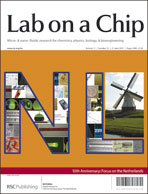Emergent behavior in particle-laden microfluidic systems informs strategies for improving cell and particle separations†
Abstract
Colloidal particles placed in an energy landscape interact with each other, giving rise to complex dynamic behavior that affects the ability to process and manipulate suspensions of these particles. Propagating across scales ranging from the local behavior of 10's of particles to non-local behavior encompassing >106 particles, these particle interactions are pervasive and challenging to describe quantitatively, especially in the confined environments typical of microfluidic devices. To better understand the effects of particle interactions in this context, we have performed experiments and simulations involving a simple microfluidic device in which hydrodynamic and electrostatic forces are leveraged to concentrate and separate particle mixtures. These investigations reveal the mechanisms underlying the dynamic patterns formed by micron-scale particles as they impinge on a dielectrophoretic force barrier: their tendency to aggregate and recirculate under constant operating conditions, and to reorganize when the operating conditions are changed. The emergent behaviors of these ensembles of interacting particles exhibit features of dynamical frustration and cooperativity that suggest non-intuitive strategies for concentrating and sorting suspensions. Finally, we present a simple analytic model based on hydrodynamic coupling that captures important features of strongly interacting particle suspensions.


 Please wait while we load your content...
Please wait while we load your content...